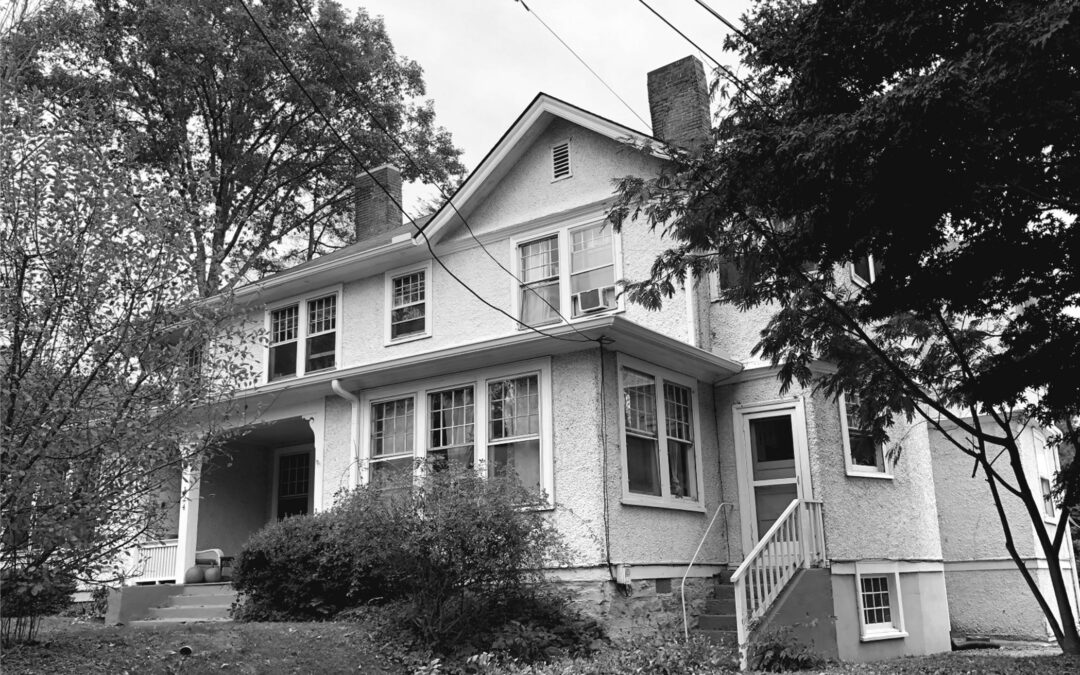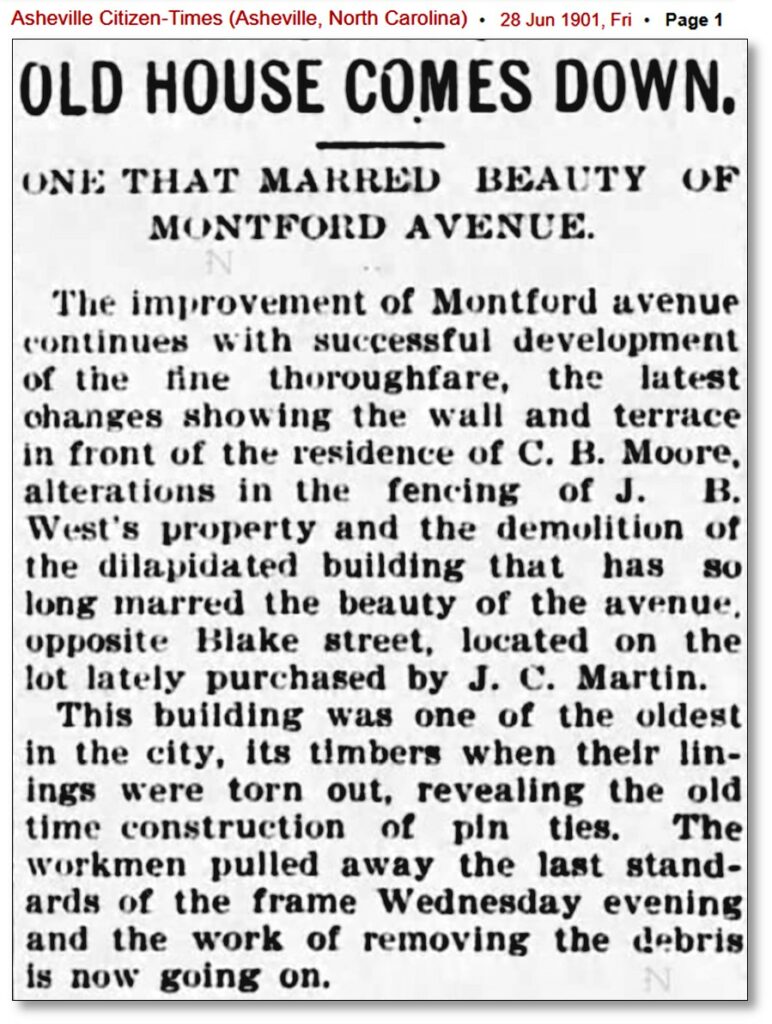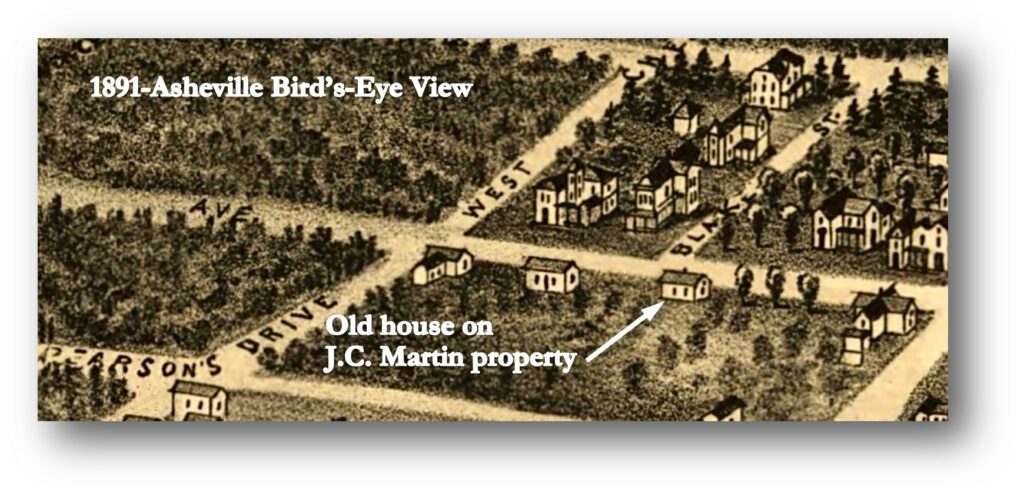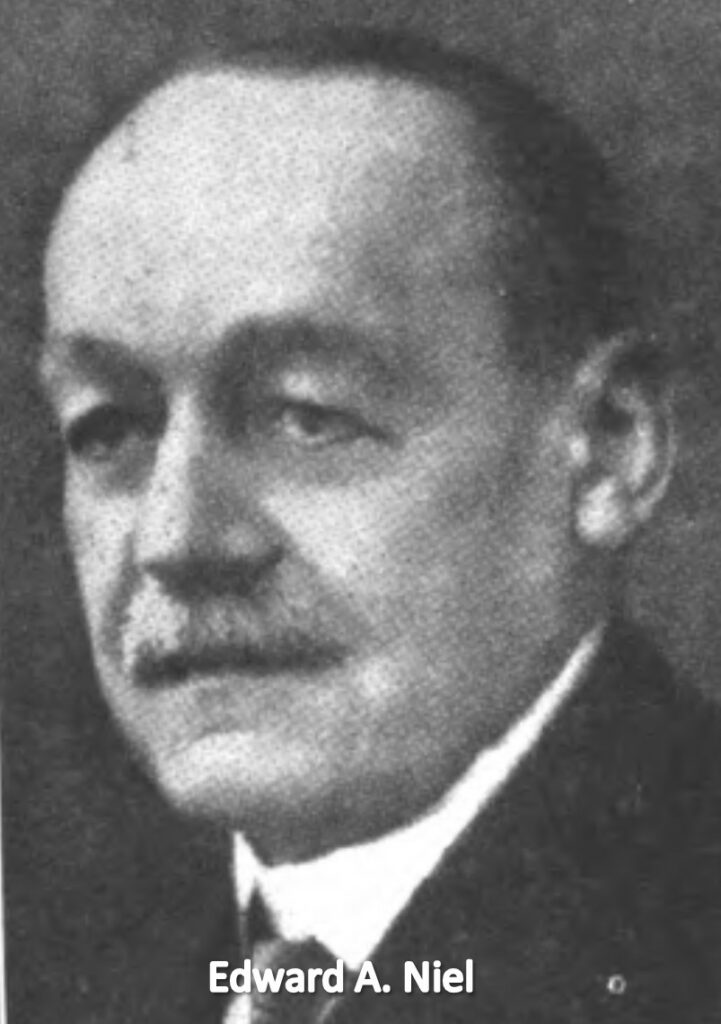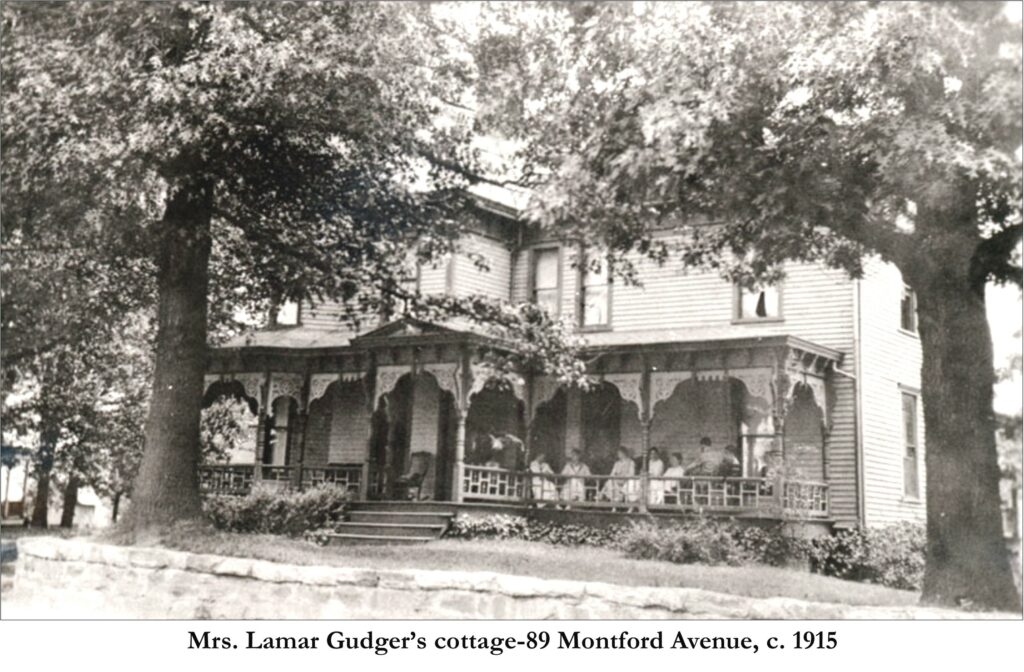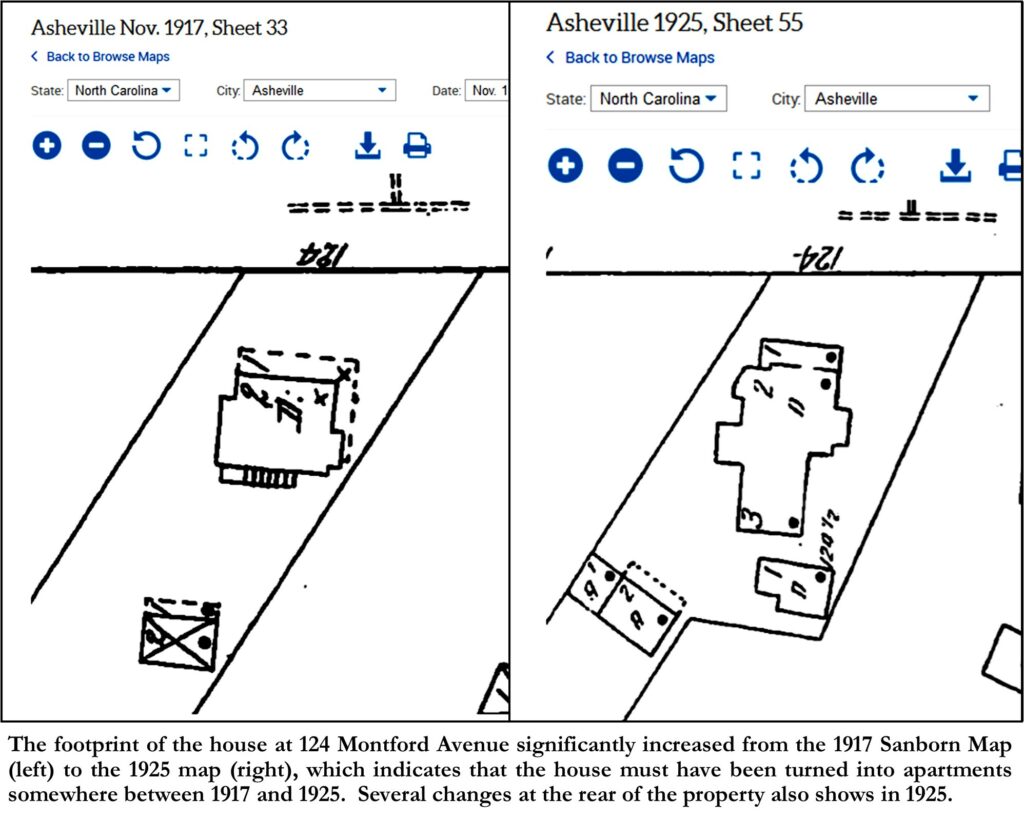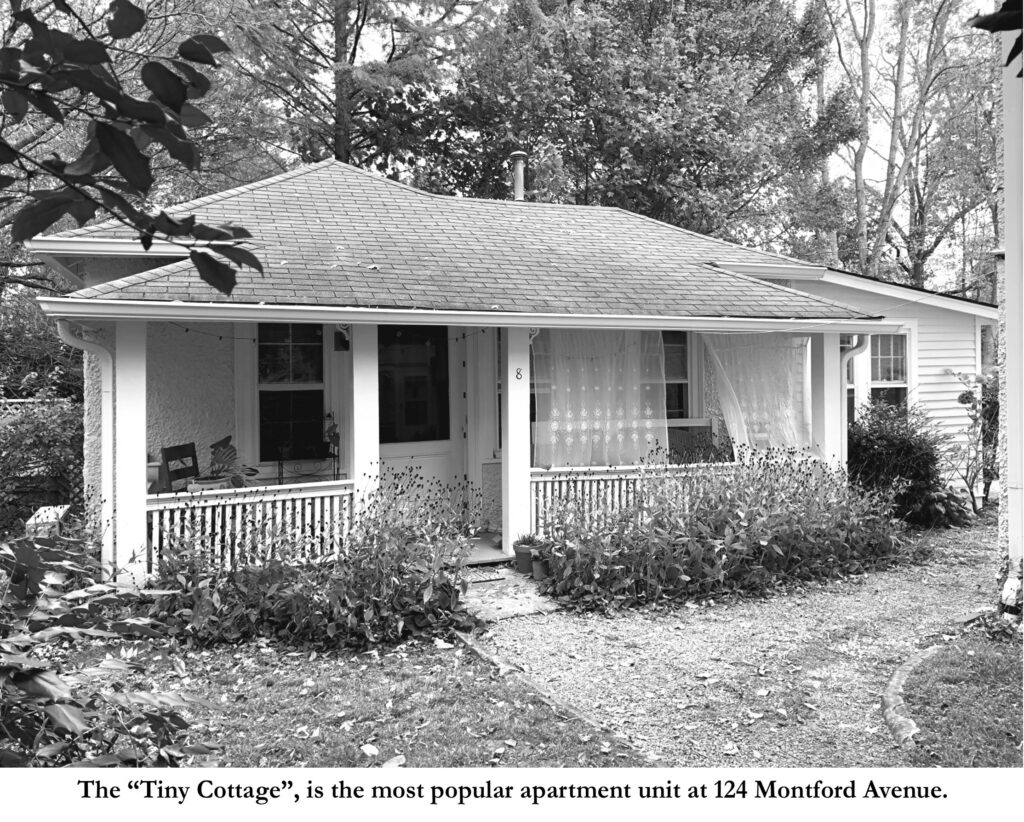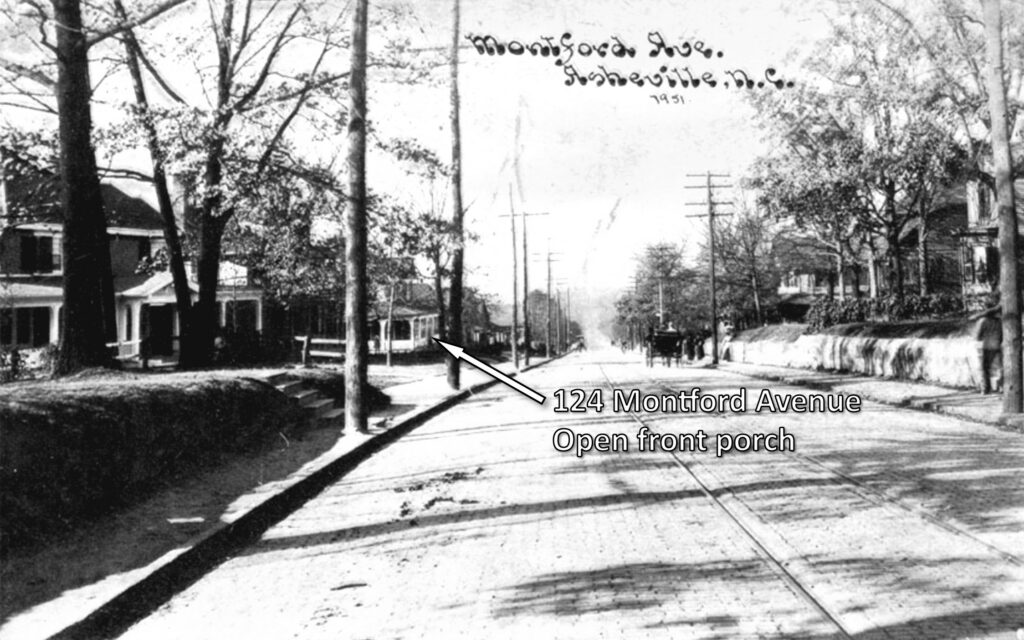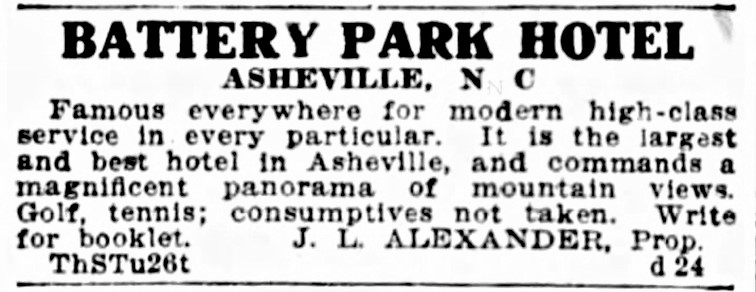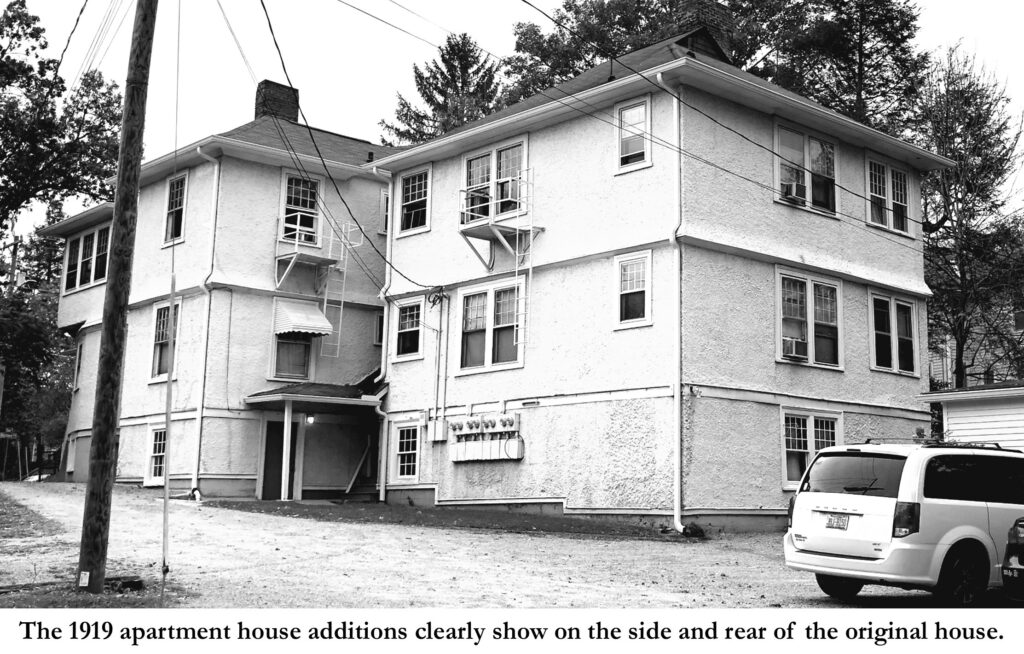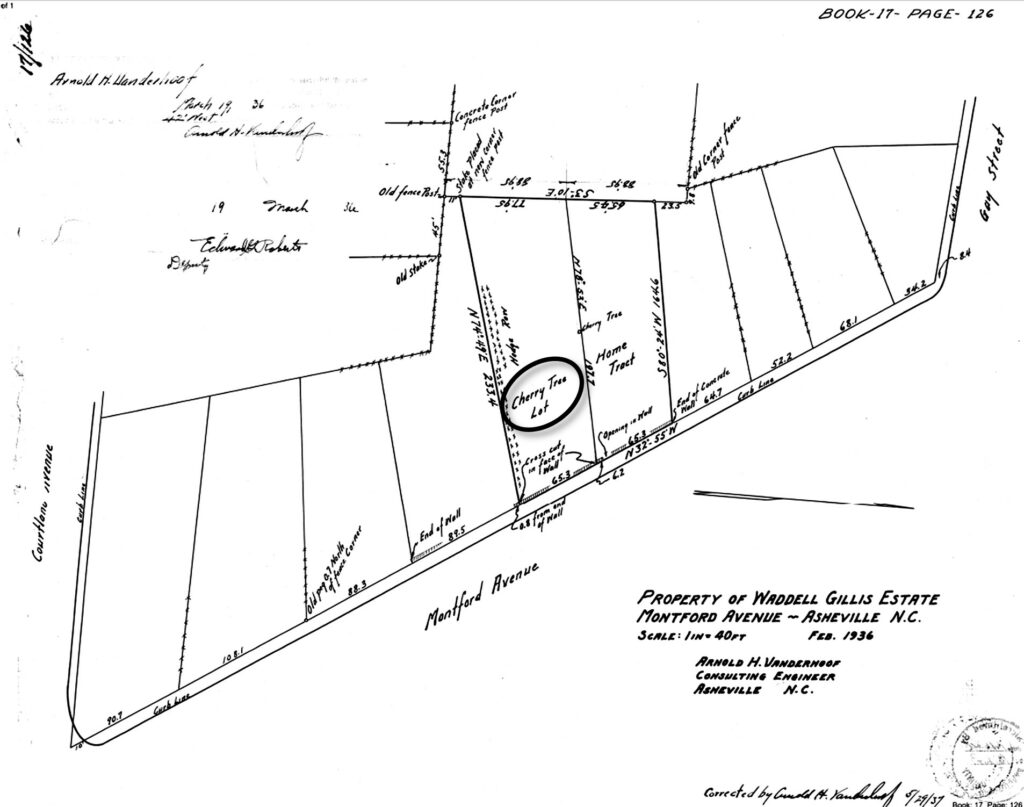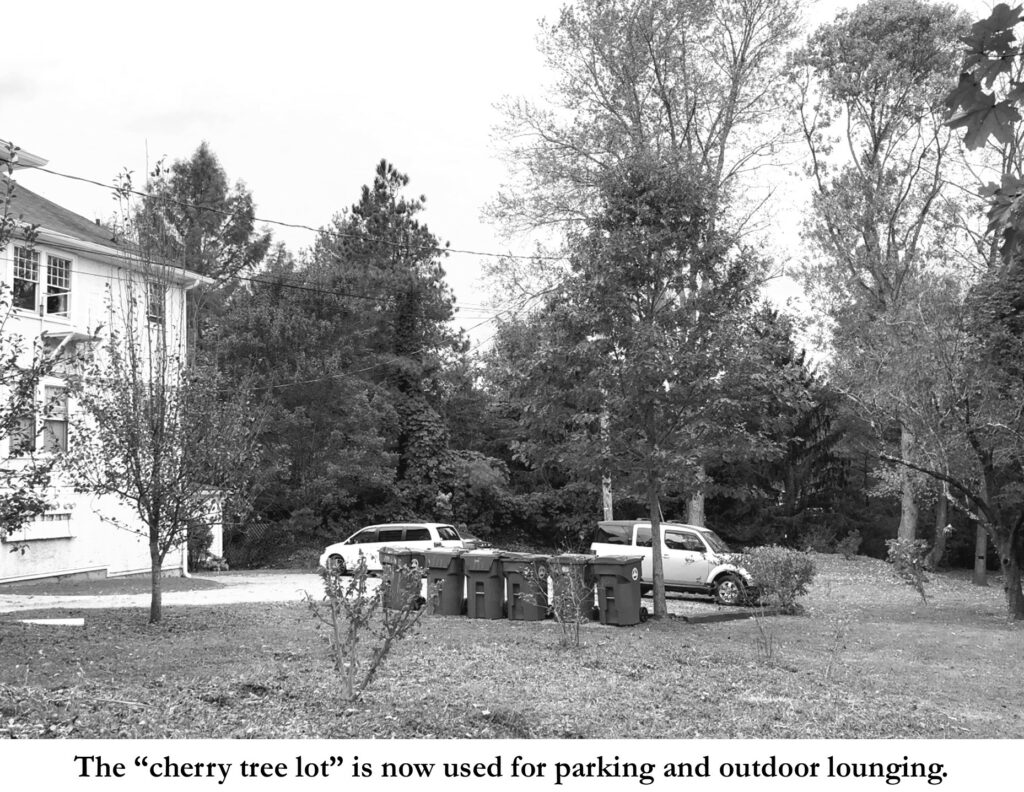By Dale Wayne Slusser
The owner of the property at 124 Montford Avenue recently sent an inquiry to the Preservation Society inquiring about the history of their property, an apartment house obviously dating from the early 20th century. Two specific statements made by the owner, describing the property, not only sparked, but guided my research: “It doesn’t seem to ever have been a single family home the way it’s laid out. Also, the big vacant lot beside it looks like it has never been built on”. During a few days of laser-focused research, I concentrated on trying to answer those two implicit questions–Was it ever a single-family dwelling? And why does it have an large accompanying vacant lot that appears to never have been built on? As I suspected, in uncovering the answers to those two questions, the overall history of the property revealed itself. I thought this would be a good lesson to share on how to perform historical research on a property, using the resources available to us via the internet and the increasing availability of digitized records and resources.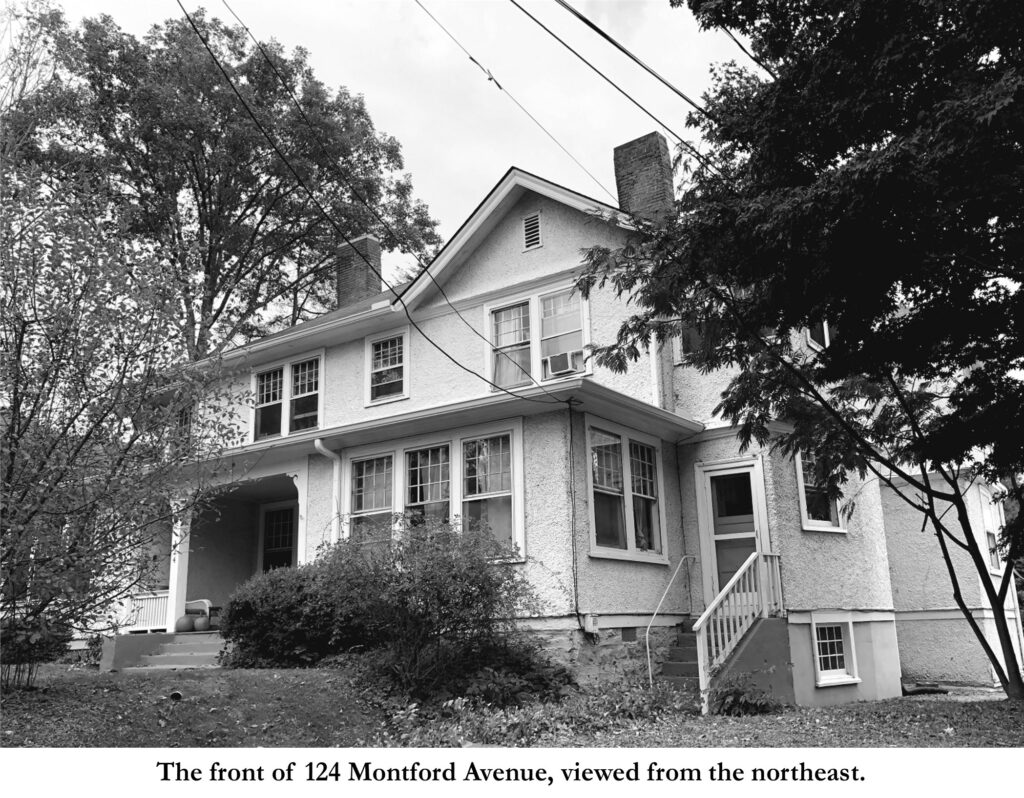
Although sometimes I first do a bit of internet browsing on a property, the primary thing that I do is a thorough deed search to develop a “chain of title” for the property, starting with the current owner. By accessing the county GIS (Geographic Information System) I access the current property information, which includes not only the current owner’s name but also gives the latest deed reference (book and page number), from whence one can begin the chain of title. The deed search is then done by accessing the register of deeds website. In the case of the 124 Montford Avenue property. I first traced the chain of title back to 1903, as my pre-deed-search internet browsing had brought up a photo of the property at the Buncombe County Special Collections with the following description: “Either Julius Martin or E.A. Niel may have built this house. Niel is in the 1903 city directory as its first occupant.”.[1] The 1903 deed[2] showed the property transfer from Julius C. Martin to E. A. Niel-actually I arrived at this deed by using what is called “the recital” in the deeds, which were in most older deeds, which references the previous deed or deeds for that property. The recital usually begins with a phrase such as: “Being the same property conveyed to the grantor…”, and usually follows immediately after the property description. In our case this was helpful as (and here is a mini-lesson) although Niel’s name was correct on the deed, on the deed database it was incorrectly transcribed as “Edward R. Neil” instead of “Edward A. Niel”-misspelling both his middle initial as well as his last name. So, when searching for records, I always search under suspected misspellings, such as “Neil” instead of the correct “Niel”, in fact I even found a few records (not in the deeds) where they spelled his name “Neal”.
In the 1903 deed I was looking to see what price Niel paid for the property, as this often can indicate whether the property was a vacant lot or had a house on it. Of course, the deeds don’t always give the price, or sometimes they give a vague sum such as, “for Ten dollars and other considerations…”. But in our case the deed indicated that Niel purchased the property for $1,450, and although Julius Martin had cobbled the property from two previous transfers[3] in 1901, for which cumulatively he paid only about $800, the increase in the sale price, which can be an indicator of an “improvement” (like building a house on the lot), in my experience was not sufficient enough to confirm that Martin had “improved” the property, by building a new house on it, before selling it to Niel. However, I did find a newspaper article that indicated that Martin had “improved” the lot, not by building a new house, but by clearing out an old house! (A modern-day preservationist’s nightmare!) In a June 28, 1901 newspaper article titled, “Old House Comes Down”, it was reported that among the improvements being made to Montford Avenue is “the demolition of the dilapidated building that has long marred the beauty of the avenue opposite Blake Street, located on the lot recently purchased by J. C. Martin.”[4] The article further described: “This building was one of the oldest in the city, its timbers when their linings were torn out, revealing the old time construction of pin ties. The workmen pulled away the last standards of the frame Wednesday evening, and the work of removing the debris is now going on.”[5] This “old house” shows on the 1891 Bird’s-Eye View of Asheville, on the westside of Montford Avenue directly across from Blake Street, as described in the article. Also from my experience, I knew that even in 1903 in Asheville, that a house such as that built at 124 Montford Avenue, would have cost at least double the price Niel paid for the property. So, this indicated to me that Martin most likely did not build the house, merely he just cleared and cleaned up the lot. Of course, then I had to find evidence to verify if Niel built the house.
Although the newspapers, during that time often reported the building permits that were issued, and sometimes even reported the architect and or builder of a house being constructed, I could find no reference of the kind for the house at 124 Montford Avenue. However, along with the fact that the house address does not show in the city directories until 1904 (albeit as 120 Montford) then showing Niel as the resident, I also found a deed of trust which Niel had taken out in July of 1903 for $3,000[6], just two months after purchasing the lot from Martin. A deed of trust, like a mortgage, pledges real property to secure a loan. This document is used instead of a mortgage in some states. While a mortgage involves two parties, a deed of trust involves three: the trustor (the borrower), the lender (sometimes called a “beneficiary”), and the trustee. The trustee is an independent third party that holds “bare” or “legal” title to the property. The trustee’s primary function is to sell the property at a public auction if the trustor defaults on payments. [7] The $3,000 that Niel borrowed is more in line with the cost of a house of that size, and because Niel borrowed the money after the purchase of the property, I find these two occurrences to be compelling evidence that Niel used that money to build the house.
Another way to reinforce or support that Niel built the house in 1903 was to research who was “E. A. Neil”, and to follow his movements during the years 1903-1904. For this, I used newspapers.com and genealogybank.com, but there are also other sources of digitized newspapers databases online available to researchers. Using these sources, as well as general web searching, I found the Edward Anthony Niel was a native of Selma, Alabama, who was born on July 3, 1865 to Andrew J. & Elizabeth (Peake) Niel.[8] Following in the footsteps of his father, in 1894, Niel started working for the railroad, first serving in various positions with the Mobile and Birmingham Railroad, but then in 1899 he secured the position of assistant general freight agent for the Southern Railroad at Washington, DC.[9] It was while living in Washington DC that Niel’s wife, Flora Stewart Niel fell ill, necessitating their seeking a more mild climate, at least temporarily. In November of 1899, the Selma, AL newspaper announced that “Mr. & Mrs. E. A. Niel reached the city yesterday from Washington, DC, and are the guests of Mr. & Mrs. M. W. Walker. Mrs. Niel will spend the winter in Asheville.”[10] About two weeks later, in December 1899, the Asheville newspaper reported that “Edward Niel, freight agent of the Southern, left for Washington today after visiting Mrs. Niel, who is a guest at Mrs. Basler’s.”[11] A quick search of the 1899 Asheville City Directory[12] revealed that “Mrs. Basler’s”, was a boarding house at 40 N. French Broad Avenue, operated by Mrs. Agnes T. Basler. I’ll not glut you with all the references, but will summarize that by searching the newspapers, I discovered that the Niels, mainly Mrs. Niel, continued to winter in Asheville in 1900 and 1901, while maintaining their residence in Washington DC. In February of 1901, Mrs. Niel was reported as seriously ill while wintering in Asheville. However, she seemed to rally and by 1902 she was able to move with her husband to Atlanta, where he had been transferred. Actually, as head of his department, Niel coordinated the moving of his entire office and staff from Washington DC to Atlanta in the Fall of 1902. I assume he was hoping that Atlanta would be a better climate for his wife-however in the May of 1903, the Asheville papers were abuzz with the news that “SOUTHERN OFFICIAL MOVES TO ASHEVILLE- MR. E. A. NEIL [sp] GENERAL FRIEGHT AGENT RENTS A HOUSE ON MONTFORD”.[13] The article further reported that “Mrs. Niel is at L. S. Rorison’s on Montford [65 Montford Avenue]”, and that because “Mrs. Niel’s health is so much better here and both are so much pleased with Asheville”, that the Niel’s have decided to make Asheville their permanent residence, with E. A. Niel continuing to work from Atlanta. And “to this end yesterday”, it was further reported, the family “rented Mrs. H. Lamar Gudger’s cottage on Montford which Mrs. Niel and children will occupy this week.”[14] Modern-day readers would recognize “H. Lamar Gudger’s cottage” as the house at 89 Montford Avenue at the corner of Montford and Bearden Avenues. In 1978, the Lamar Gudger House was acquired by the Preservation Society of Asheville and Buncombe County and became one its first success stories, and today the house is used as the offices of Montford Family Law.
As the above-mentioned article, was written on May 12, 1903, the day after the Niels had rented the Gudger cottage, and just the day before they signed the deed of transfer for the lot from Julius C. Martin (dated May 13, 1903) it is obvious that there was no house for them to move into on the lot, as they would not have gone to the expense and trouble of signing a rental agreement for two days! Combine that with the July deed of trust for $3,000, and the fact that the address does not show up until the 1904 city directory, I feel safe to say that the overwhelming evidence confirms that the Niels had the house built at 124 Montford Avenue, sometime in the summer-fall of 1903.
Tragically, Mrs. Niel did not get to enjoy her new residence for very long. On April 19, 1904, just a few months after the Niels had moved into their new house, the Asheville newspaper reported: “Mrs E. A. Niel, wife of the general freight agent of the Southern railway, is seriously ill at her home on Montford Avenue and little hope is entertained for her recovery. Mr. Niel, whose headquarters are in Atlanta, has arrived in response to telegrams announcing Mrs. Niel’s critical condition, and is now at the bedside.” [15] And not surprisingly, the April 20, 1904 Asheville Citizen Times, reported the sad news: “Mrs. E. A. Niel, wife of the general freight agent of the Southern railway, died at 6:05 o’clock yesterday morning at the home, 120 Montford Avenue”.[16] The same day, her obituary in the Montgomery Advertiser, Montgomery, AL reported that “For Five years, she had been ill with consumption.”[17] Of course, “consumption” was the polite word for Tuberculosis, which obviously was why the Niels had moved to Asheville, which then was a premier “health resort” for those suffering with tuberculosis.
Now that we have settled not only who built the house, but that the house was built as a single-family residence, it now begs the intriguing question-When did it become an apartment house? And of course, implicit in that question are also the questions of who and why? To answer the short question of when, I consulted the Sanborn Fire Insurance Maps. From 1867 to 1977, the Sanborn Map Company of Pelham, New York, produced large-scale (usually 50 feet to the inch) color maps of commercial and industrial districts of some 12,000 towns and cities in North America to assist fire insurance companies in setting rates and terms. The intervals between new map editions for a given town or city in the early decades of the twentieth century varied according to the pace and scale of urban growth — from a few years to more than five years. The maps were designed to assist fire insurance agents in determining the degree of hazard associated with a particular property and therefore show the size, shape, and construction of dwellings, commercial buildings, and factories as well as fire walls, locations of windows and doors, sprinkler systems, and types of roofs. The maps also indicate widths and names of streets, property boundaries, building use, and house and block numbers.[18] I access the Sanborn Maps through nclive.org, using my Buncombe County Library card, however, there are other websites where they can be accessed as well.
Looking at the Sanborn Maps for Asheville, I noticed that the footprint of the house at 124 Montford Avenue significantly increased from the 1917 map to the 1925 map, indicating that the house must have been turned into apartments somewhere between 1917 and 1925. Looking at the 1925 map and comparing it to the 1917 map, I noticed several changes to the property. First, it was obvious that the house was expanded to the rear with a 3-story addition (signified by the “3” on the lower left of the house footprint), which matches its current configuration. Another two changes show in the rear yard. First, the existing two-story garage (signified by the “A” on the plan) appears to have been turned and moved slightly northwest, with the addition of a one-story garage bay to the northwest. The second change to the rear of the property that shows on the 1925 map is the addition of a small one-story dwelling to the southwest, which shows on the map as addressed as “124-1/2”. This small cottage, known in the day (1930’s-1950’s) as the “Tiny Cottage”, is still used today as the most popular unit in the apartment complex.
One change that shows on the 1925 map is that the front porch that originally wrapped around the southside of the house, to the bay window, seems to have had the southside section torn away. However, the 1951 Sanborn map shows the southside section intact, but as enclosed, just as it is now. I believe the 1925 map was an error-but nonetheless the fact remains that the original porch (prior to 1925) was fully open on both the east (front) and south sides. A circa 1911 postcard, titled “Montford Avenue, Asheville, NC”[19], shows both sides of the porch as fully open.
Once I narrowed the timeframe to between 1917-1925, it was easy to figure out the “who”, by looking at the Chain of Title that I had previously prepared. It turns out that the Niel family held onto the house until 1909, five years after the death of Flora Niel. In 1909, Edward A. Niel and Edna Mary Niel sold the property to J. L. Alexander and his wife Florence M. Alexander. But before finding out which owner it was that may have built the apartments, I had to satisfy my inquisitiveness, as to why E. A. Niel held on to the house, and who was “Edna Mary Niel” shown on the 1909 deed? I will not tax my readers with how I found the answers-but I will summarize my findings. What I had missed in my earlier research was that Flora Stewart Niel’s mother, Mrs. Anna J. Stewart, who by 1903 was a widow, had moved into the new house with her daughter Flora and her husband and their children, Edward and Flora (both same names as their parents). After the death of Flora Niel in 1904, Mrs. Stewart remained in the home, no doubt to take care of her motherless grandchildren, whose father, Edward A. Niel continued to commute out of town to work. Niel was working from Atlanta when his wife passed away, but in September of 1904, just a few months later, he accepted a new position as the General Freight Traffic Manager of the Atlantic & North Carolina railroad, headquartered in Goldsboro, NC, [20] and then in 1905, Niel resigned that position and accepted a new position as Traffic Manager and Vice-President of the Coal Properties with the Buffalo & Susquehanna Railroad.[21] Apparently Niel’s mother-in-law had to take care of the children during his frequently long absences. In November of 1908, Edward Niel remarried to Edna Mary Post in Buffalo, NY. Up until 1909, the Asheville City Directories listed Edward Niel and Mrs. Anna J. Stewart as living at 124 Montford Avenue. The 1909 directory showed only Mrs. Anna J. Stewart, no doubt as the Niel family had moved to Buffalo, NY by then.
As mentioned earlier, the Alexanders purchased the property in 1909 from the Niel family, but as they sold the property in 1921 to R. C. & Ida Scruggs, that meant that it may have been either the Alexanders or the Scruggs that turned the house at 124 Montford Avenue into an apartment building. So, my next step was to search the newspapers for any revealing clues. I first searched for clues using the name R. C. Scruggs, as I thought that since the Alexanders owned the property in 1917 when it was still a single-family dwelling, and the changes showed in 1925, that it mostly likely was the Scruggs family that made the changes. Although I did find references to the Scruggs operating the house as the “Haldane” apartments, I could not verify that they were the ones to turn the house into apartments, or whether they purchased the house as apartments. So, it was on to researching the J. L. Alexander family and their movements and interactions, as it seemed most likely that it was they who turned the house into apartments.
When the Alexanders purchased the house in 1909, James Lawrence Alexander was acting as the manager of the Battery Park Hotel, one of Asheville’s premier hotels of the late-19th century, which first opened in 1886. Alexander managed the hotel for the heirs of Frank Coxe, the original owner. Not only was Alexander successfully transitioning the hotel into the twentieth century (transitioning carriage service into chauffeured automobiles), but it was reported that the hotel which had “played an important part in the many advertising campaigns which had been conducted in behalf of Asheville,”[22] and that under “Mr. Alexander’s regime the hotel paid the biggest profits of it’s existence.” The Alexander family, which included James and his wife Florence, and their five children had been living at the Battery Park Hotel prior to purchasing the house at 124 Montford Avenue. The family removed “from the Battery Park Hotel to their residence on Montford Avenue” near the end of November of 1909.[23]
In 1914, J. L. Alexander decided not to renew his lease on the Battery Park hotel management[24], and then in 1915 Alexander accepted a new position as the manager of the Washington Hotel in St. Louis, MO.[25] One year later, Alexander sold his interests in the St. Louis hotel and accepted a new position as the manager of the Hotel Petersburg in Petersburg, VA. Although the family joined J. L. Alexander in St. Louis and Petersburg at times, they still maintained their Asheville home. In fact, Mrs. Alexander and the children often returned to Asheville for long stays. But then in 1918, the Asheville papers announced that Mrs. J. L. Alexander was living at and operating the boarding house, “Shadowlawn” at 103 Montford Avenue.[26] Of course, that piqued my interest! James L. Alexander had put the 124 Montford Avenue into his wife’s name in 1910[27], just a few months after they had acquired the property. So why, in 1918, was Mrs. J. L. Alexander living in another house, though she still owned the house at 124 Montford? I immediately went back to the Buncombe County deeds to see if J. L. or “Mrs. J. L.” had purchased another or additional property on Montford Avenue?
Although the search of the deeds indicated that they had not purchased the additional house, it did reveal something that explained why Mrs. J. L. Alexander had moved to another house and was operating it as an income-producing property. In February 1919, the Alexanders filed for a legal separation, as they had already been “living separate and apart on account of divers disputes and unhappy differences”.[28] Although this may bring up personal issues in their relationship, which are not in the purview of our study, the “Deed of Separation” is important to understanding how the apartments came to be. First, it explains why Mrs. J. L. Alexander, who was now known as Florence M. Alexander, had moved to 103 Montford Avenue. Also, the four-page document is very detailed giving numerous terms of the separation. One important term was that J. L. Alexander paid Florence $1,500 in lieu of her “dower interest” in his property, which meant that she relinquished any claims or interests in J. L. Alexander’s property if he were to pre-decease her. And on other hand, another term of the agreement was that Florence “shall own and enjoy independent of any claim or right of J. L. Alexander all the property of the said Florence M. Alexander, both real and personal, now held by her or which shall hereafter belong or come to her, as her sole separate property…”.[29] Not surprisingly, in June of 1919, while still living at 103 Montford, Florence put the following ad in the newspaper under the “Unfurnished” rental column: “124 Montford Avenue-9 rooms, 2 baths, screened sleeping porch, coal and gas ranges. Garage. Two servants’ rooms. Apply Mrs. Florence M. Alexander, 103 Montford Avenue.” [30] But then, just a few months later, Florence came up with a brilliant solution.
“APARTMENT HOUSE ON MONTFORD AVENUE-MRS. J. L. ALEXANDER BUILDING HOUSE AT NO. 124”[31], announced the December 19, 1919 edition of the Asheville Citizen Times. The article further reported that: “Work has started in converting the residence of Mrs. J. L. Alexander at No. 124 Montford avenue, into a large apartment house, containing three stories, the cost to be several thousand dollars.”[32] There it was-the answers to the “who and why”, as well as the “when”! Just an interesting note–it was Florence Alexander, not the Scruggs, who first named the apartments “The Haldane”. I surmise that it was named for her son, Dana Haldane Alexander, who at the time was serving as a pilot with the Royal Flying Corps of the British Army in England and France.[33]
Now, for the final question. “Was the large vacant lot to the north of the building part of the original property? Well, the answer to that question was found by following the deed transfers in the chain of title. The chain of title revealed that the vacant lot, described in the deeds as “the Cherry tree lot”, did not become part of the apartment house property until 1943.[34] The “cherry tree lot” was part of the original property of the Elisabeth W. Gillis house at 134 Montford. The lot was sold out of the Gillis family after the 1936 death of Mrs. Gillis’ daughter, Miss Waddell Gillis, and shows on a plat prepared for the Waddell Gillis estate.[35] In 1943, sisters Anne & Margaret Coble purchased the vacant lot (not sure why), and a few months later they purchased the 124 Montford Property. The following year, 1944, they sold both properties as one two-tract property, and it has remained as such since then.
All questions answered with relative ease, but with lots of research time. In college, when I trained to be a librarian, our instructors often reminded us that it was not important that we know the answer to a patron’s inquiry, but that it was more important that we knew WHERE to find the answer. So it is with historical research!
Image Credits:
Photo of front of 124 Montford Avenue; “Tiny Cottage” photo; Rear of 124 Montford photo; Cherry tree lot photo-all by Jamie Moody, Finance and Operations Manager, Preservation Society of Asheville & Buncombe County.
Recital in 1903 Deed- 05/18/1903 Julius C. Martin to Edward A Niel (of the City of Atlanta) MONTFORD AVENUE Db. 129/484. -Buncombe County Register of Deeds.
“Old House Comes Down”- Asheville Citizen Times, June 28, 1901, page 1.
“Birds-Eye View, 1891”-Library of Congress website: https://www.loc.gov/item/75694894/ , captions by Dale Slusser
- A. Neil photo-“Edward A. Niel”, by Ernest Briars, Correspondent, Rochester. Baltimore & Ohio Magazine, Volume XXVII, No. 1, January 1941, published by Baltimore & Ohio Railroad, Baltimore, MD.
- Lamar Gudger House- at 89 Montford Ave .-Collection Number:16580 ID: A610-8, Buncombe County Special Collections.
Sanborn Maps-via nclive.org, captions by Dale Slusser
Montford Ave. postcard-Collection Number 18398 Image ID AB431, Williams, C.U. (Bloomington Il), Publisher –Buncombe County Special Collections
Battery Park Advert- Boston Evening Transcript (Boston, Massachusetts), January 7, 1909, page 15.
Cherry Tree Plat-03/19/1936 Waddell Gillis Estate PLAT MONTFORD AVENUE Db. 17/126. -Buncombe County Register of Deeds.
[1] Image #A630-8- Buncombe County Special Collections, Pack Memorial Library, Asheville, North Carolina.
[2] 05/18/1903 Julius C. Martin to Edward A Niel (of the City of Atlanta) MONTFORD AVENUE Db. 129/484. -Buncombe County Register of Deeds.
[3] Deed recital states: “Being western portion of the lot acquired from Donald Gillis …deed dated April 27, 1901…in book 120, page 3…and the triangular lot conveyed by Elizabeth J. Wiggins to Julius C. Martin by deed dated June 13, 1901…in book 116, page 417…”.
[4] “OLD HOUSE COMES DOWN-ONE THAT MARRED BEAUTY OF AVENUE”, Asheville Citizen Times, June 28, 1901, page 1.
[5] Ibid.
[6] 07/31/1903 Edward A & Flora Niel to D C Waddell (party of the second part), Tench C. Coxe, Mary Coxe, Frank Coxe Estate (parties of the third part) [D/T] CORRECTED 6/3/2020 Db. 56/479. “Whereas Edward A Niel is justly indebted to the said parties of the third Part for the sum of Three Thousand dollars ($3,000)…as reference to one promissory note…”
[7] “What’s the Difference Between a Mortgage and Deed of Trust?” by Amy Loftsgordon, Attorney. https://www.nolo.com/legal-encyclopedia/whats-the-difference-between-mortgage-deed-trust.html
[8] “Edward A. Niel”, by Ernest Briars, Correspondent, Rochester. Baltimore & Ohio Magazine, Volume XXVII, No. 1, January 1941, published by Baltimore & Ohio Railroad, Baltimore, MD.
[9] Ibid.
[10] The Selma Times, Selma, Alabama, November 25, 1899, page 4.
[11] Asheville Citizen Times, December 11, 1899, page 4.
[12] Maloney’s Asheville, N.C. City Directory [1899-1900], J.L. Hill Print. Co., Richmond, VA, and Maloney Directory Co., Atlanta, GA., page 140. Accessed at: https://lib.digitalnc.org/record/24890?ln=en (Note: also available at the Buncombe County Special Collections, Pack Memorial Library, Asheville, North Carolina.)
[13] Asheville Weekly Citizen, May 12, 1903, page 2.
[14] Ibid.
[15] Asheville Citizen Times, April 19, 1904, page 5.
[16] Asheville Citizen Times, April 20, 1904, page 8.
[17] Montgomery Advertiser, Montgomery, AL, April 20, 1904, page 6.
[18] Info from: https://web.lib.unc.edu/nc-maps/sanborn.php and https://www.loc.gov/rr/geogmap/sanborn/san4a1.html
[19] Postcard titled: “Montford Avenue, Asheville, NC”- Collection Number 18398 ID AB431, Williams, C.U. (Bloomington Il), Publisher –Buncombe County Special Collections, Pack Memorial Library, Asheville, North Carolina.
[20] The Daily Journal, New Bern, NC, September 17, 1904, page 4.
[21] Alabama Beacon, Greensboro, AL, May 24, 1905, page 1.
[22] Asheville Citizen Times, October 14, 1914, page 7.
[23] Asheville Citizen Times, November 17, 1909, page 5.
[24] Asheville Citizen Times, October 14, 1914, page 7.
[25] Asheville Citizen Times, October 5, 1915, page 6.
[26] Asheville Citizen Times, May 19, 1918, page 24.
[27] 01/03/1910 James L. Alexander to Florence M. Alexander MONTFORD AVENUE Db. 160/127.-Buncombe County Register of Deeds.
[28] 02/21/1919 James L. Alexander to Florence M. Alexander DEED OF SEPARATION Db. 228/54.-Buncombe County Register of Deeds.
[29] 02/21/1919 James L. Alexander to Florence M. Alexander DEED OF SEPARATION Db. 228/55.-Buncombe County Register of Deeds.
[30] Asheville Citizen Times, June 22, 1919, page 22.
[31] Asheville Citizen Times, December 19, 1919, page 9 .
[32] Ibid
[33] “Asheville Boy Gets unusual Distinction-Lieut. Dana H. Alexander of the Royal Flying Corps, First Among Six Hundred”-Asheville Citizen Times, July 25, 1918, page 14.
[34] 03/29/1943 Cole D. & Marjorie Scruggs Genge to Anne Coble (“the Cherry tree lot”) Db. 548/290. And 04/13/1943 R. C. & Ida G. Scruggs to Anne & Margaret Coble MONTFORD AVE (Apartment house lot) Db. 550/133.-Buncombe County Register of Deeds.
[35] 03/19/1936 Waddell Gillis Estate PLAT MONTFORD AVENUE Db. 17/126. -Buncombe County Register of Deeds.

